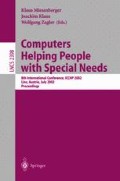Abstract
An alternative text-input method is considered as a model for a menu selection task through manipulation by a single button. A traditional seven-segment display element was used as a layout for symbol input and imaging. Each of the segments was lighted in a temporal sequence and the writer could choose the segment by pressing a button. Instead of the button any switch or similar signal may be used, as well as visual imaging may be substituted by sounds. When all segments have been cycled, the result was interpreted as a character according to a set of rules and depending on the character set used. A physically impaired person to control a computer or other electronic device could use the method. The rationale for the design and the results of a preliminary evaluation are presented.
Access this chapter
Tax calculation will be finalised at checkout
Purchases are for personal use only
Preview
Unable to display preview. Download preview PDF.
References
ASL Product information available at: http://asl-inc.com/ProductCatalog.asp
Keytools ™ Product information available at: http://www.keytools.com/input/ability.htm
Mind Controlled Switch, information available at: http://www.mctos.com/htm/mctos.htm
Kirsh, D.: Complementary Strategies: Why we use our hands when we think. In Proc. of the 17th Annual Conference of the Cognitive Science Society. Hillsdale, NJ, Lawrence Erlbaum (1995). Available at: http://cogsci.ucsd.edu/~kirsh/Cogsci95/cogsci95.html
Lauruska, V.: Computerized Control and Communication System for Handicapped. In: Klaus, J., Auff, E., Kremser, W., Zagler, W.L. (Eds.): Proc. 5th Int. Conference ICCHP’96, (Linz, Austria). Verlag R. Oldenburg, Wien Munchen (1996) 515–520
Partala, T., Aula, A., and Surakka, V.: Combined Voluntary Gaze Direction and Facial Muscle Activity as a New Pointing Technique. In Hirose M. (Ed.) Proc. of INTERACT 2001, Tokyo, Japan, IOS Press. (2001) 100–107
FlexVoice 2 text-to-speech engine. Product information available at: http://www.flexvoice.com/demo.html
Author information
Authors and Affiliations
Editor information
Editors and Affiliations
Rights and permissions
Copyright information
© 2002 Springer-Verlag Berlin Heidelberg
About this paper
Cite this paper
Evreinov, G., Raisamo, R. (2002). Cyclic Input of Characters through a Single Button Manipulation. In: Miesenberger, K., Klaus, J., Zagler, W. (eds) Computers Helping People with Special Needs. ICCHP 2002. Lecture Notes in Computer Science, vol 2398. Springer, Berlin, Heidelberg. https://doi.org/10.1007/3-540-45491-8_53
Download citation
DOI: https://doi.org/10.1007/3-540-45491-8_53
Published:
Publisher Name: Springer, Berlin, Heidelberg
Print ISBN: 978-3-540-43904-2
Online ISBN: 978-3-540-45491-5
eBook Packages: Springer Book Archive

